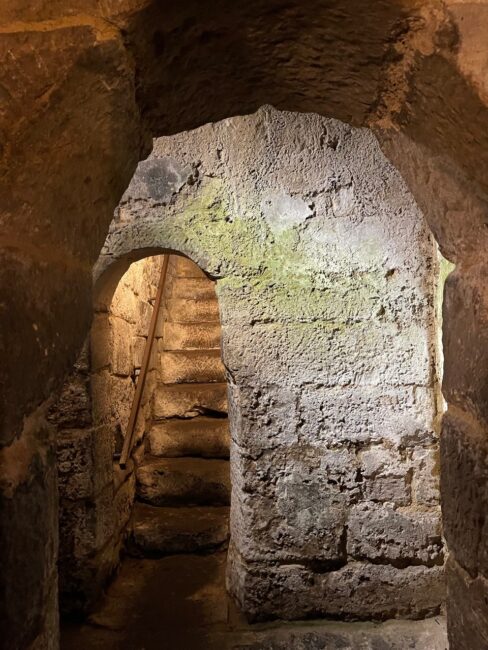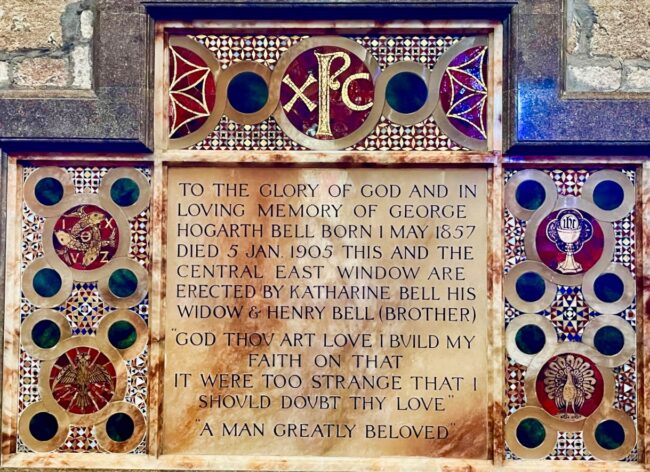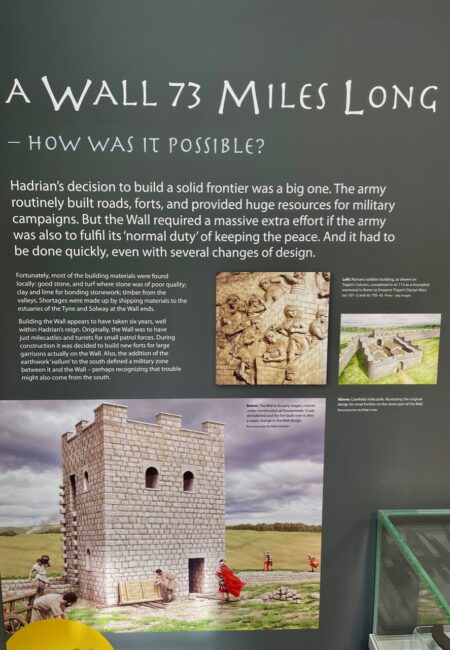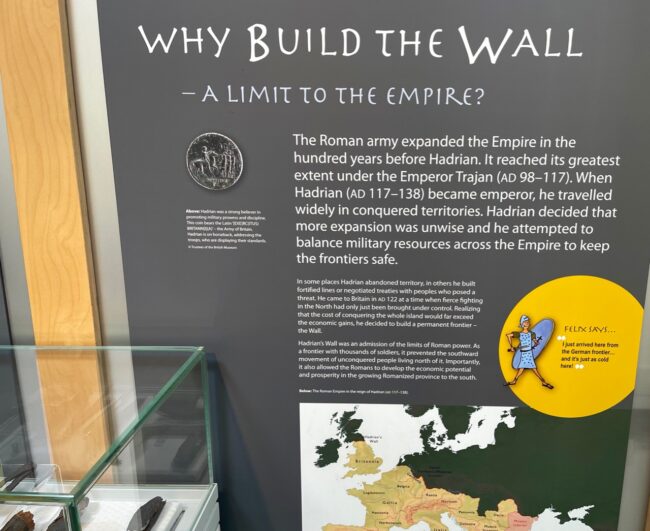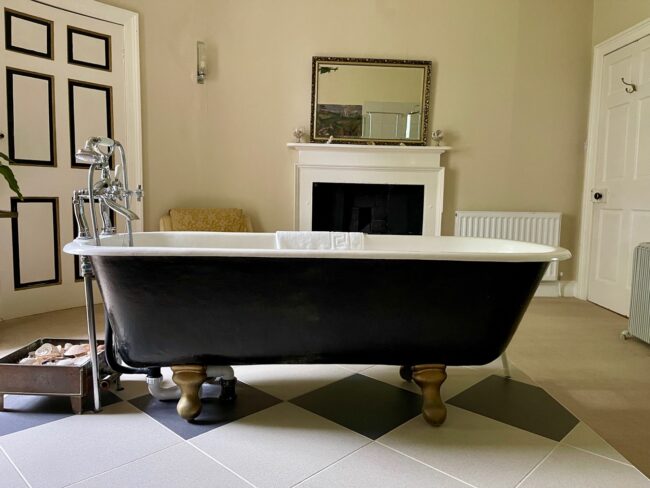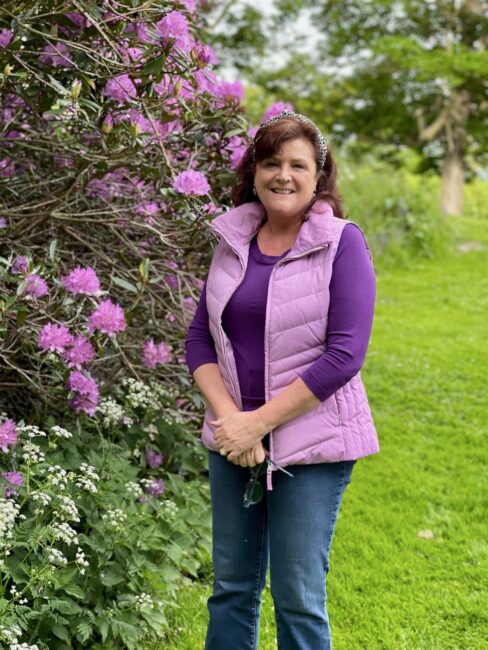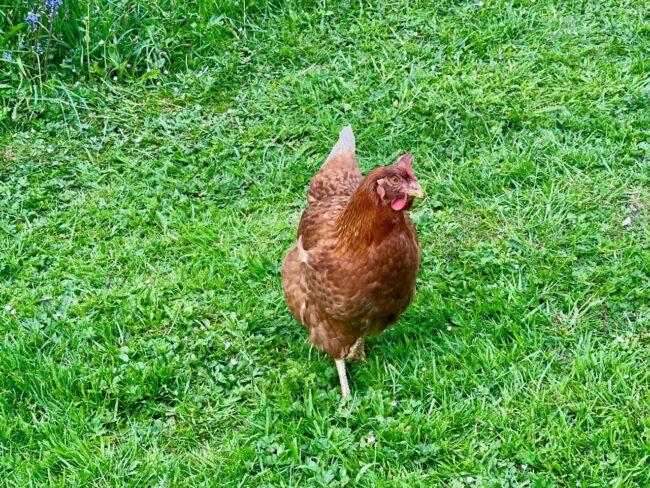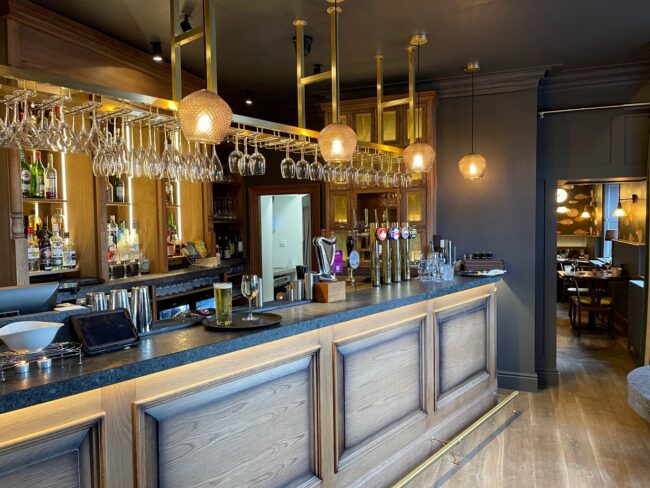
CHAPTER EIGHT: An Unusual Day In Durham
July 21, 2022
CHAPTER TEN: Trying Not To Get Poisoned In Alnwick
July 30, 2022Surviving Mai Tai Tom’s “Royal” Blunder: 2022 England & Scotland
CHAPTER NINE: Enjoying The Northumberland Countryside
Day Nine: Mirror Image, Going Back To The Seventh Century, Is This Any Way To Go To The Bathroom?, Hitting The Wall, That’s A Ewe Problem, Mixed Messages, “A Palace Of The Modern Magician”, Two Heads Are Better Than One, Country B&B, Buttering Us Up, Tracy Takes It On The Lamb and The Crew Hits The Crewe
Our plan was to get on the road and drive to see part of Hadrian’s Wall, but first we had to actually get on the road safely. For some reason, the side view mirrors would not fold out on our rental car. Kim thought they’d open automagically like they did the previous day, but after a short distance they still would not fold out. It’s hard enough to drive on the other side of the road with mirrors, so not having them presented a problem. Having put the wrong petrol in the car in Gubbio, not knowing how to put the car in reverse in Spello and running into a light pole in Olomouc, we were used to these rental car fiascos, and fortunately Kim figured it out.
Less than 50 minutes from our hotel, our first stop was, what else? An abbey. Hey, it’s what we do. Hexham Abbey dates back to the 7th century and was founded by the incredibly busy St. Wilfrid.
With a little renovation work in the 12th century, you really do feel like you’ve stepped back in time when you walk inside.
 I thought it best not to attempt that staircase as we had other venues to see, and my doctor back home had probably blocked me from his phone after yesterday’s call.
I thought it best not to attempt that staircase as we had other venues to see, and my doctor back home had probably blocked me from his phone after yesterday’s call.
We checked out the Phelps organ, which I hoped would play the Mission Impossible theme. The Font is said to be from St. Wilfrid’s time.
At the bottom of the Night Stairs is the nine-foot tall Flavinus’ Tombstone from the 1st century. It was discovered in 1881 under the floor of the abbey, and the tombstone is dedicated to Flavinus, hence the name. There are lots of other sculptures to be found. Many of these predate St. Wilfrid by centuries.
Hexham Abbey’s nave is full of banners that “mark some of the most important events, regiments and people in the history of Northumberland.” I guess they could have been called Banner events.
Although the stonework around the stained glass windows date to the 13th century, the original windows were destroyed by Puritans.
I was going to descend the stairs down into the Saxon Crypt, but after yesterday’s debacle Tracy thought I might get lost. The crypt is basically unchanged from what it looked like 1,300 years ago.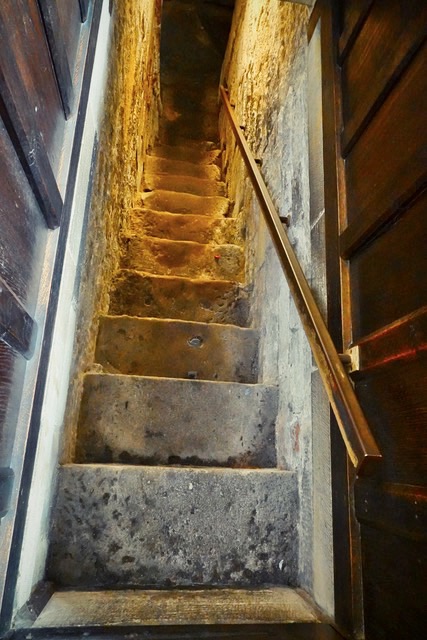
She was able to grab a photo and come back up before becoming part of a Stephen King novel.
A list of rulers of the abbey through the centuries was set in stone.
There was more to see there …
.. and we could have stayed a bit longer …
… but we had a fort to visit and were already running late. We wanted to see a portion of the 73-mile long Hadrian’s Wall and headed to one of the permanent Roman army posts, Housesteads Roman Fort & Museum.
Before we hiked up to the museum, we overheard a man outside the Visitor Center regaling people with tales about going to the bathroom … in Hadrian’s time. Before we had time to escape, he told us how the soldiers would use a moss brush that was marked so you wouldn’t use somebody else’s brush by mistake. For added effect, he took us over to a visual of how soldiers went to the bathroom, and finally had me re-enact that scenario on a replica of one of the ancient toilets, using the brush for special effects … and I thought getting lost in a hotel was embarrassing. I did receive a modicum of applause and laughter from the visitors forced to witness my Oscar worthy role.
It was quite a blustery day, but the hike up to the museum and fort was fun, with sheep joining us for part of the journey. Evidently, they had not seen the shenanigans below.
One of Hugh Masekela’s greatest hits came to mind.
At the museum we learned about the construction of the fort and why they built the wall. There are plenty of exhibitions, including a film, that went into great detail. It was £10 for Tracy and £9 apiece for the elderly three to visit the museum and fort.
The wind was whipping pretty good as we channeled our inner child and climbed all around the fortress.
Kim lead the way up the steps and we followed.
The views over the countryside seemed to stretch forever.
The northern part of the fort at the top of the hill is where you can really get an idea of how far the wall stretched.
There are remains of the barracks blocks and the Commandant’s house and the accompanying signage gives you an idea of what the buildings looked like. I thought it was just cool to walk around in something that was built about 1,900 years ago.
Kids and adults both enjoyed walking and climbing on the rectangular ruins of this fort that once housed 800 auxiliary soldiers for nearly three centuries.
For some reason, I just can’t escape the loo at Housesteads.
I’m guessing we wandered around up here for the better part of an hour taking in the expansive views and ruined fort.\ 
Kim and Mary got a head start on walking back, and about ten minutes later Tracy and I followed. We, however, ran into a roadblock. Out of the blue, the sound of two barking border collies riding with a man in a souped-up red ATV pierced the peaceful morning we were enjoying. As bad as that was, it was much worse for the sheep who immediately went on alert and started running faster than Usain Bolt.
We felt bad for one ewe who most certainly couldn’t find her lamb. Finally, they were reunited and scurried down the hill to another pasture. Of course, their ultimate fate was probably not a good one, since we were told the wool industry is suffering mightily and most of the sheep are used for meat.
Our next destination took a little longer to get to thanks to some dispute between Mary and my GPS system. We went with Mary’s, and the next thing we heard was Tracy seeing a sign whiz by and saying, “I don’t think we want to go to Newcastle.” Since nobody was in the mood for an ale, we recalculated.
Finally, we arrived much later than we had planned at “Britain’s first smart home,” Cragside House, Gardens & Estate, the Victorian family mansion of Lord William Armstrong, dubbed “The Magician of the North.”
Armstrong was a master of all trades; an inventor, scientist and philanthropist who was knighted in Queen Victoria’s Golden Jubilee year for giving his gun patents to the British government. Cragside was the first building in the world to be lit by hydroelectricity. It was built with additions between 1869 and 1895.
Armstrong was also “a landscape genius, and constructed five lakes and planted more than seven million trees and shrubs” on the property. Just walking up to the estate, we witnessed much of the landscape beauty.
Inside, we saw some of Armstrong’s handy work. In the ”Designer” Kitchen, for instance, there’s a hand-operated dumb waiter, a dishwasher and a water-powered roasting pit over the range.
The dining room table could seat just the Armstrongs or be expanded to accommodate 30 guests.
Armstrong acquired the Egyptian onyx fireplace in the Library on a trip overseas, and the stained glass windows depict the legend of St. George. You could read in this room thanks to Armstrong “harnessing the power of Cragside’s artificial lakes” to provide hydro-electric light. I told you this guy was smart.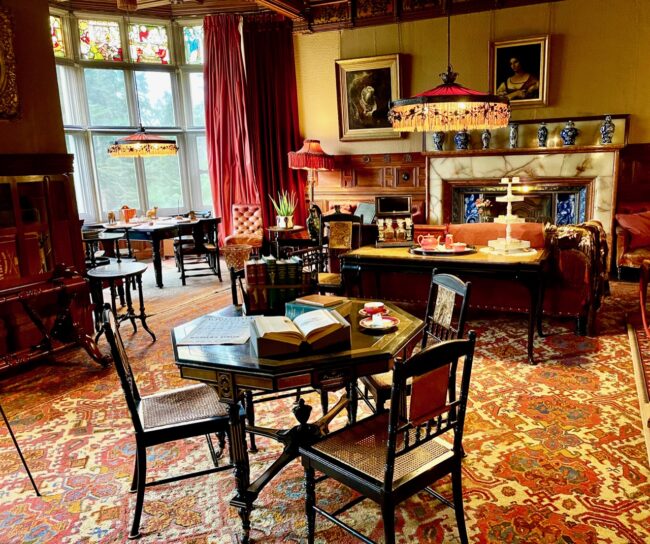
Speaking of beautiful fireplaces, this carved stone one stood out too.
Armstrong also built a private spa, which he referred to as “Turkish Baths.” The water was heated by a boiler in the basement.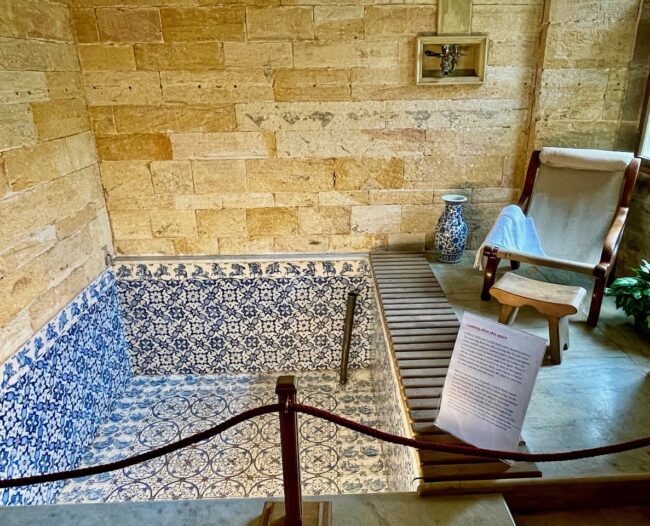
We were seeing red in this bedroom.
There’s nothing like walking through the Morning Room in the late afternoon.
The Gallery contained lots of paintings and sculptures. This is another room that Armstrong’s genius helped light with 12 overhead lamps.
Perhaps the most beautiful part of the house is the Drawing Room. It has an elliptical glass ceiling …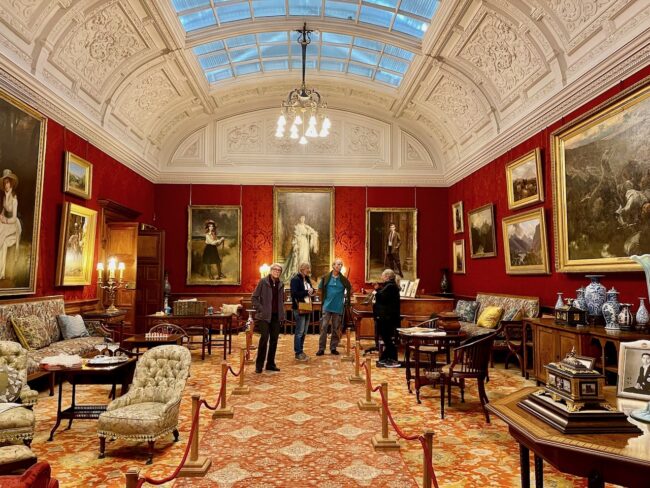
…and an incredibly enormous marble fireplace.
Finally, we entered a room where you could learn more about Armstrong’s inventions regarding electricity. It was pretty fascinating, but it was nearly closing time. It was time to “head” out.
Walking outside, a large downpour had just ended.
We thought about strolling down to the gardens, however the rock steps, now soaking wet, made for a precarious journey. Time constraints also precluded us from taking the scenic drive. Not getting to spend more time here was one of the biggest disappointments of the trip, and who knows if we will ever be back to this part of the world.
It was about 45 minutes to our next destination, the tiny town of Bamburgh, where we would stay in a nearby country inn, Budle Hall.
Owned by Ralph (pronounced Rafe) and his wife Celia. We were also greeted by the very cute Ziggy, who had a little trouble making eye contact with the camera.
The house is grand, and we were led up the staircases to our two large rooms. 
Speaking of large, when I went to check out the bathroom (there seems to be a theme going on today), I opened the door into a room of gigantic proportions. There was a shower in the corner and a clawfoot tub in the middle. I felt like a country squire, until I remembered I didn’t own the property.
Ralph had invited us down to the parlor where he served tea and gave each one of us a butter cookie, which immediately changed our lives. This was, hands down, the best shortbread cookies on the planet. Ralph gave us some background on the property, and how he and his wife are sharing in the relief efforts to help Ukranian refugees. Mary reminded me, “They are lending a portion of their B&B to a family of three and trying to help the mother get her 9-year-old daughter and 11-year-old son settled in private boarding schools. They are also housing a young female refugee.”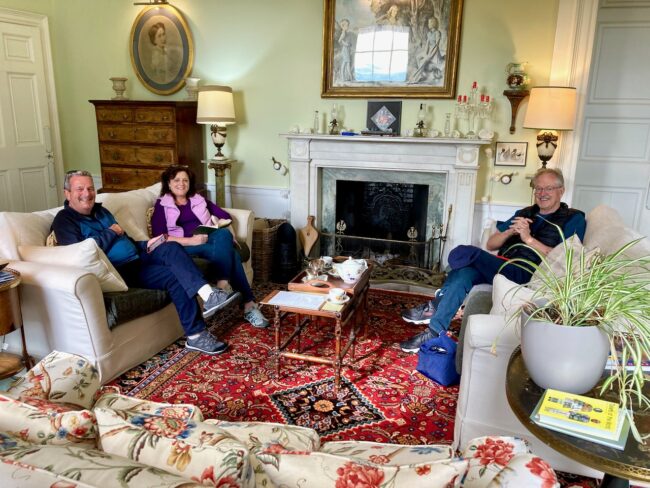
Mary and Kim headed back upstairs for a little R&R, while Tracy, Ralph and I walked out onto his pastural property.
There we met more sheep, and Tracy and Ralph walked out to feed the lucky sheep that’s off limits for potential lamb chops as his son raised it while he was home from school during Covid.
Tracy and I strolled the grounds gazing in wonder at the forest of rhododendrons.
It was a great trip for rhodys.
We also met some other residents of the property as we walked around the lush grounds. Now we know why those eggs were so fresh at breakfast each morning.
Our group highly recommends a stay at Budle Hall when you’re in this neck of the world.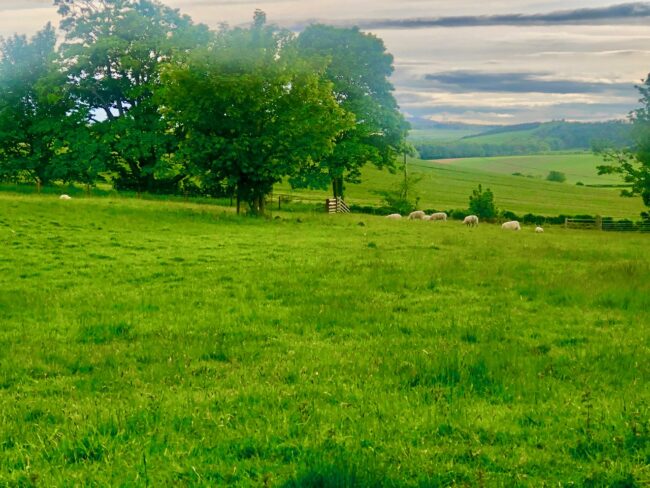
It’s a short distance into Bamburgh, and it was hard not to miss the huge castle that we’d visit in a couple of days. 
The newly renovated Lord Crewe was our dinner choice for the first evening, and it was a good choice, as were all three restaurants we dined at while staying here (post on all three restaurants here).
I will proclaim that the light and crispy Beer Battered Cod with tartare sauce, lemon and hand-cut chips, were the best fish and chips since Pastis in 2011 on our New York City excursion.
We settled in for the evening back at Budle Hall.
 Tomorrow, we’d leave early to visit a couple of castles and two gardens, where at one of them we’d learn that we could actually die if we weren’t extra careful.
Tomorrow, we’d leave early to visit a couple of castles and two gardens, where at one of them we’d learn that we could actually die if we weren’t extra careful.
CHAPTER TEN: Trying Not To Get Poisoned In Alnwick
Day Ten: Parking Problems, Please Don’t Eat The Plants, “I Didn’t Know Gardening Was So Dangerous”, Not Blooming Soon Enough, Why Is My Tongue Blue?, 700 Years Of History, Hey Hotspur, “Deeply Eccentric Castle”, Castle Hoarders, More Butter Cookies and Swan Diving








